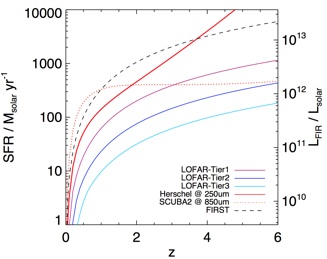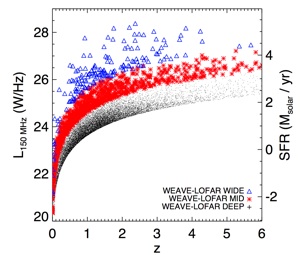WEAVE-LOFAR
Team Lead: Dan Smith
The Low Frequency Array (LOFAR) is a new-generation radio telescope, with unparalleled sensitivity and survey speed due to its very large instantaneous field of view, a result of its innovative design. The LOFAR Surveys Key Science Project is producing tiered surveys across the entire northern sky, providing precise positions for WEAVE, which will be its primary source of redshift information. The WEAVE-LOFAR survey will perform multi-object and resolved optical spectroscopic (MOS and IFU) follow-up of more than a million low-frequency selected radio sources, enabling a very wide and exciting range of science questions to be addressed. Topics range from measuring the evolving relationship between star formation and accretion, to identifying radio galaxies deep in the epoch of reionisation.
Figure 1: Star formation sensitivity as a function of redshift, for the LOFAR Surveys Key Science Project, in comparison to confusion-limited images from Herschel Space Observatory and SCUBA-2, as well as the 1.4 GHz FIRST survey.
Figure 2: The 150 MHz and SFR sampling of the input catalogues for the three tiers of the WEAVE-LOFAR MOS survey (symbols as in the legend). Our simulations indicate that we expect to approach a redshift success rate of 100% for sources at z < 1.
The MOS survey is designed in three tiers (Wide, Mid and Deep) designed to efficiently sample the redshift luminosity plane. As well as providing redshifts (which will be extremely efficient, due to the dominance of emission-line galaxies and AGN in the faint radio source population), WEAVE spectroscopy is ideal for classifying radio sources according to their power source, whether this is star formation or accretion, and for distinguishing between their accretion modes. WEAVE-LOFAR will therefore provide the large statistical samples of sources to study the interplay between these processes as a function of mass, environment and redshift.
Some of these details (and many others) are described in the latest paper describing the WEAVE-LOFAR survey, which can be downloaded here.

